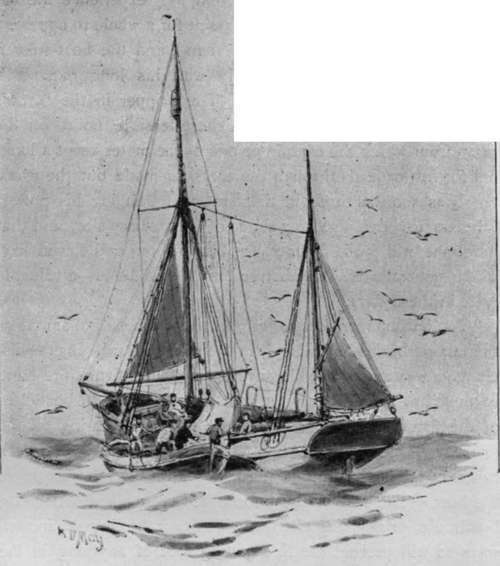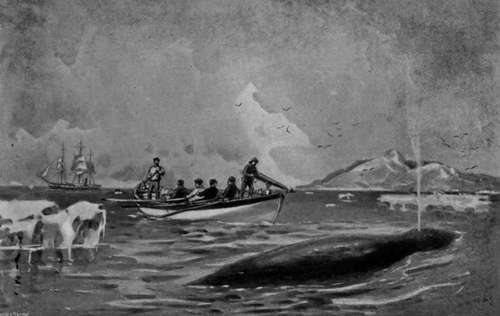Chapter XVI. Whaling. Greenland Whale. Balaena Mysticetus
Description
This section is from the book "Sea Fishing", by John Bickerdyke. Also available from Amazon: Sea Fishing.
Chapter XVI. Whaling. Greenland Whale. Balaena Mysticetus
'A fa—a—a—all !1 A fa—a—a—all !' No man with the true British instinct of sport running in his veins will ever forget the first time he heard this old whaling cry ; indeed, for anyone to thoroughly realise the excitement this yell produces on board of a whaler, he must have been present and have assisted at the capture of a fish.
1 A ' fall'—three derivations are given to this word : 1st. Dutch word ' val,' signifying man the boats ; 2nd. Dutch word ' wall'— pronounced ' val'—a whale ; 3rd. English word ' falls,' viz. stand by the ' falls' or tackles by which the boats are lowered.

A whaler.
Let the reader imagine a whaler with her maintopsail aback more or less surrounded by ice, and two boats on the ' bran' (an expression used for a boat on the look-out for fish when none are in sight), the oars in the men's hands but carefully kept out of the water, placed at such points along a floe or near a heavy piece of ice as from long experience the old skipper considers the most likely point for a whale to appear.
A fish suddenly rises near at hand, and the boat-steerer, sweeping the boat round gently with his long oar, sculls noiselessly towards the monster. The skipper in the ' crow's nest' (a barrel placed at the highest feasible point on the mast, from which the captain or one of the mates keeps a lookout for fish or leads through the ice) has made out the whale nearly as soon as those in the boat, and bringing his powerful glass to bear, discovers she is of no ordinary size, and that her bone will probably measure between ten and eleven feet, which generally realises about a ton of whalebone—a valuable prize in these days.
The harpooneer rises to his gun, there is a puff of smoke as the missile buries itself deeply in the fish, and, swinging the discharged weapon out of his way, he thrusts or throws the hand harpoon in also. Promptly the boat-steerer sweeps the boat clear of the fish, runs his oar out of the way, and tearing off the line cover, assisted by the line manager (who pulls stroke oar), carefully tends the line as it runs rapidly down the centre of the boat. The rest of the unoccupied crew place seal clubs, boathooks, or anything else that will answer the purpose, in such ways as will prevent the line getting foul of anything in the boat.

'A fish suddenly rises close to one of the boats'.
Owing to the position of the boat and a heavy piece of ice which obstructs his view, the skipper cannot see what has happened ; but hardly has the dull report of the harpoon gun caught his ear than he sees over the ice the fast flag 1 rise, and a faint cry of ' A fall ! a fall !' comes over the water, taken up by those on deck, and, rumbling down into the officers' quarters and forecastle, gathers volume as the men bursting up from below, many of them half dressed with their clothes tied in a bundle snatched hastily from a hook especially provided for the purpose alongside their bunks, rush to the five or six remaining boats. Each man, as he reaches the deck, makes for the nearest unoccupied seat or thwart, except the harpooneers, boat-steerers, and line managers, who retain their position in any boat.
In the meantime a harpooneer at the falls forward and a boat steerer aft lower the boat into the water, dropping into it the quickest way they can, often by sliding down the falls. The falls are unhooked, and pulling two or three oars the scantily dressed members of her crew struggle rapidly into their clothes. Indeed, in an incredibly short time, probably less than three minutes, every boat will be clear of the ship, and rowing to the position assigned to it by the skipper in the crow's nest, who, observing which way the fish is heading, will endeavour to so place his boats that one of them shall be near the fish when she rises.
If there is any danger of the fish taking the whole of the fast boat's lines (600 fathoms or 1,200 yards), which is not at all an uncommon event, a signal is made by holding up an oar with a bucket on it, and should the line in the boat be rapidly decreasing, two, three, or more oars will be added according to the emergency of the case ; then the nearest boat will race up, and detaching her harpoons bend on the end of her lines to the look or eye which is spliced at the end of the ' stray line ' of the fast boat.
1 Each boat is supplied with a jack or fishing flag, which is kept flying until the fish is either lost or killed. The ship has a similar flag, so that when a number of ships are in company the crews can distinguish which ship's boats are fast to the whale. As long as your harpoon is fast to the fish and you have hold of the line it is your fish. If another ship's boat fastens your fish under these circumstances, even though your harpoon draw afterwards, it is still your fish.
In the meantime the whale, whose speed on being first fastened is estimated to be from eight to ten miles an hour by that careful observer and scientific whaling skipper, Scoresby, has taken from a line and a half to two lines ; but the harpooneer, watching his opportunity, has got a turn or two of the line round the bollard head, which considerably depresses the bows of the boat, and cutting into the hard wood produces smoke, on which No. 2 is pouring water to prevent it from catching fire.
In about thirty minutes 1 the fish rises, if all goes well, near one of the loose boats, which, racing up to her, places harpoons as circumstances best allow, and if the boat happens to be very near and the fish much blown, there may be time to get in a thrust or two of the lance. These tactics are repeated until the victim has received sufficient harpoons to insure her capture, then each time she rises and a boat can approach her the lance alone is used, till at length she spouts blood, dyeing the water and boats red, and finally rolls over on her side or back, dead, when all hands cheer frantically.
Continue to:
- prev: Other Fish In Florida
- Table of Contents
- next: Whaling. Greenland Whale. Balaena Mysticetus. Part 2
Tags
fishing, hooks, bait, fishermen, spanish mackerel, mackerel fishing
